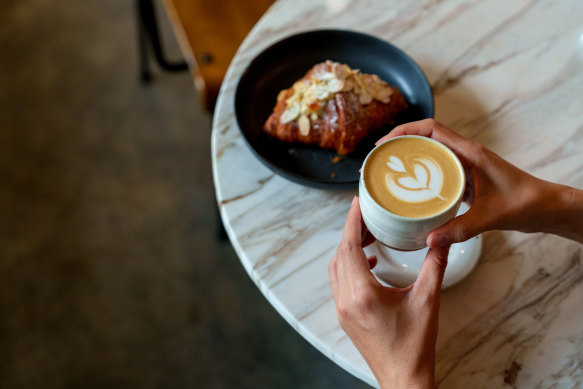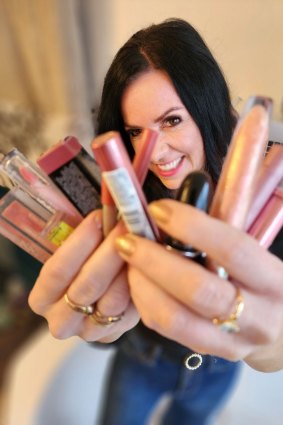This was published 1 year ago
Opinion
Why we don’t cut our cosmetics (or coffees) in tighter times
Nicole Pedersen-McKinnon
Money contributorI don’t drink coffee, but I do wear lipstick – so let me declare that I know a bit about one and nothing about the other. And I probably have a significant budgetary bias – I’ll get to that shortly.
But our appetite for both coffee and cosmetics is changing as this cost-of-living crisis gets acute. It’s not the first time it’s happened either – let me introduce you to the Lipstick Index.

Buying coffee and lipstick give us a hormone hit that ensures we won’t slash our spending on them when times are tight.Credit: iStock
Estee Lauder’s chairman, Leonard Lauder, coined this term when he noticed a surprise outcome during the early 2000s recession: lipstick sales went up, not down.
Indeed, the same inverse relationship between our prosperity and propensity to purchase lipstick has been observed all the way back in the Great Depression and held true during the pandemic, too.
Today, with beauty product ranges dramatically expanded, the phenomenon extends to other make-up and skincare products. And it appears to be in full swing here.
Another global cosmetics giant, L’Oréal, has just reported its best-ever six months on record with 15 per cent growth to June in its international consumer products division.
Meanwhile, the region that includes Australia surged an “outstanding” 23.6 per cent in the first half of the year, and in Australia and New Zealand specifically, demand for its chemist-tier skincare products, like La Roche Posay and CeraVe, is notably strong.
When it comes to our indulgences in downturns, there are apparently few things we are so wedded to. Except coffee.
It appears the ailing economy isn’t going to make us curb our caffeine – 75 per cent of Aussie adults drink at least one cup a day, say statistics from accumulate.com.au, while 27 per cent admit to needing it to get through the day.
But for a long while there, you couldn’t leave your home to buy it.
Coffee consumption at home commensurately increased 37 per cent in 2021 and vendors around our coffee capital Melbourne (feel free to dispute this if you know better) report that not all the clientele are back.
Let’s face it, very few people can manufacture their own lipstick; you can buy a fancy coffee machine and try to out-brew your local barista.
An espresso machine for $600 saving you (probably now) $5.50 a hit will see you ahead in 109 coffees – that could be as little as a month!

Nicole Pedersen-McKinnon with her numerous lipsticks.
Even so, anecdotally, most people still periodically treat themselves to a bought one … and it’s a fascinating psychological phenomenon that two particular high-pay-off and low-priced items – coffee and cosmetics – are almost guilt-free pleasures. The buzz is relatively budget.
There are several intoxicating factors at play:
- Shopping and feeling good about yourself boosts your serotonin – a happy hormone.
- Another, dopamine, is released when you snare a good deal or discount, and by pleasure in general. And here’s the confession of my huge money weakness: I cannot walk past a chemist bargain bin full of cheap-as-chips lipsticks. My cost-cutting compulsion sees me with a ridiculous number.
- Then you throw seductive (and addictive) caffeine into the mix, which is a source of great satisfaction for many.
One of my money mantras has long been that microspending does maximum damage.
If you flip it and look at your opportunity cost, $6 a day saved instead of spent from age 18 and invested at 8 per cent will make you a millionaire by retirement – with some $900k coming from investment returns and only roughly $100,000 out of your own pocket (that’s all about harnessing the most powerful financial asset: time).
Except that no one is thinking like that right now – we are all on wealth war footing.
Both coffee and lipstick give us a happy and hormone hit (and coffee is a drug) that ensures – when times are tight, and we are forced to curb costs elsewhere – they are routinely safe.
There is no psychological discomfort because there is barely any financial damage, we tell ourselves. They stay because they make us feel okay.
Of course, if I buy 12 cut-price lipsticks in my precise lip colour – so they are, in fact, invisible when I apply them – it is excessive and expensive therapy.
Nicole Pedersen-McKinnon is the author of How to Get Mortgage-Free Like Me. Follow Nicole on Facebook, Twitter or Instagram.
- Advice given in this article is general in nature and is not intended to influence readers’ decisions about investing or financial products. They should always seek their own professional advice that takes into account their own personal circumstances before making any financial decisions.
Expert tips on how to save, invest and make the most of your money delivered to your inbox every Sunday. Sign up here for our Real Money newsletter.